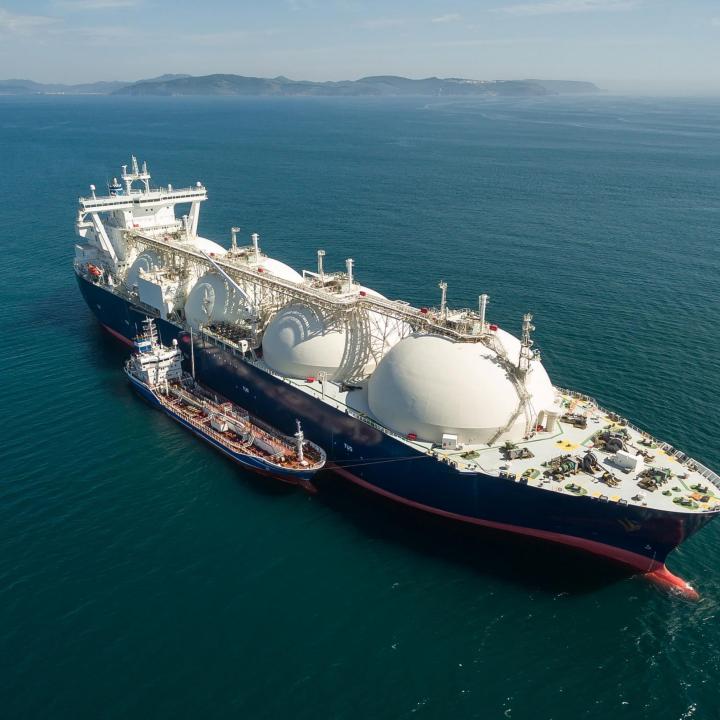
- Policy Analysis
- Fikra Forum
Coal, Oil, Gas, and Nuclear: Risks in Turkey’s Growing Energy Demands

Without further diversification of suppliers, expanded renewable capacity, strategic investments in LNG, and nuclear partnerships beyond Russia, Turkey risks exchanging one form of energy dependency for another.
Turkey’s energy demands are projected to rise significantly in the coming decades, with Turkish officials estimating that over the next thirty years, the country’s electricity needs will increase from 353 to 1,000 terawatt-hours. Similarly, according to a recent report, if the Turkish government’s vehicle fleet projections hold, Turkey’s demand for oil could more than double by 2050. These ever-growing demands have repercussions for Turkey’s economy as much as for its foreign policy.
Turkey remains heavily dependent on foreign suppliers for coal, natural gas, and oil. According to the Energy Institute’s Statistical Review of World Energy, in 2024, Turkey produced 34% of its energy from oil, 26% from gas, 26% from coal, 11% from solar and wind, and 4% from hydroelectric power. Since Turkey’s domestic coal production is insufficient to supply its power plants, it imported 26.5 million metric tons of thermal coal in 2024—equivalent to 61% of its total coal consumption.
Turkey’s domestic gas production met only 4% of consumption needs in 2024. The rest came from abroad—42% from Russia, 22% from Azerbaijan, and 14% from Iran. Turkish offshore fields discovered in the Black Sea in 2020 have raised Ankara’s hopes, but even optimistic estimates suggest they will cover only about 30% of national demand within the next decade.
Turkey’s domestic crude oil production has always been insufficient to meet demand. In 2024, its oil production averaged approximately 127,000 barrels per day. As a result, the country imported close to 1 million bpd of crude oil and refined products. These imports came from a limited number of suppliers, with Russia accounting for 56.4%, Iraq 16%, and Kazakhstan 10%. In any scenario, the country’s crude oil imports will continue to rise in absolute terms.
Without major changes, Turkey risks anchoring its future to a small set of external suppliers. Russia, Iran, Iraq, and Azerbaijan already account for the overwhelming share of its hydrocarbons. Alternative suppliers face their own constraints. Iraq lacks the export infrastructure to meet more of Turkey’s needs and suffers from political instability. Turkmenistan remains blocked by unresolved Caspian legal disputes. Egypt has become a net importer again. Relations with Israel are too fragile to support multibillion-dollar energy projects.
Between 2014 and 2024, Turkey’s electricity generation increased from 252 to 353 terawatt-hours. In the 2024 energy mix, coal accounted for 36% and gas for 19%, whereas renewable sources such as wind and solar generated 18% and hydropower accounted for 22% of total electricity production. While the shift to electric vehicles could reduce the growth in Turkey’s crude oil demand, it does not automatically strengthen energy security, as Turkey’s hunger for electricity will grow exponentially.
The Turkish government plans to rely on nuclear power to meet its growing electricity demands. Notably, 78% of the country’s electricity-generation capacity currently under construction is based on nuclear power, while 15% is based on gas. But here, too, the picture is complicated. Turkey’s only active nuclear project, the Akkuyu nuclear power plant, is financed and built by Russia’s Rosatom and will be operated by it. Once fully operational, Akkuyu is expected to meet about 10% of national electricity demand. There are plans for three additional nuclear power plants in Sinop and Thrace, with potential partners from the United States, Japan, South Korea, and China. Yet none of these agreements has been finalized.
In the meantime, Turkey may be forced to build additional gas- and coal-fired power plants to meet demand. In the past, surging electricity demand translated into greater dependence on imported hydrocarbons, especially from Russia. This risk is especially high if Turkey’s renewables expand too slowly. This structural vulnerability may leave Turkey with little room to maneuver. To secure uninterrupted flows of gas and nuclear fuel, Ankara would need to maintain close ties with energy-rich neighbors, most of which are authoritarian. Dependency, in other words, is not only an economic problem but also a political one.
The policy response must be multifaceted:
Expand generation capacity, especially from renewables. Wind and solar together accounted for less than 20% of electricity generation in 2024. Integrating more renewables into the grid will require investment in transmission, storage, and grid management.
Make modest improvements in efficiency, such as advanced conductors, grid sensors, and distributed energy management, which have been shown to unlock the equivalent capacity of new power plants.
Diversify partnerships. Depending on a single provider, whether for gas pipelines or nuclear reactors, creates long-term risk. Turkey needs a broader set of suppliers and investment partners if it is to maintain strategic autonomy. This means that it should work with countries other than Russia for future nuclear plants. If nuclear expansion proceeds without diversification of partners, Ankara may end up exchanging one dependency for another. Turkey’s intention to cooperate with the United States and South Korea on its second nuclear power plant represents an appropriate step toward diversifying its energy suppliers.
Build more liquefied natural gas (LNG) terminals and expand storage capacity. Turkey is already moving in the right direction in this regard. By 2028, the country plans to increase its natural gas storage capacity to 14.4 billion cubic meters by expanding its existing facilities. Similarly, in line with recommendations from the International Energy Agency about securing its gas supply, Ankara’s five LNG import terminals provided almost one-fifth of the country’s gas imports in 2024, with Algeria accounting for 10.3% and the United States for 10%. Moreover, Turkey’s state-owned pipeline operator, BOTAS, signed a new agreement in September with U.S. energy company Mercuria for the supply of 70 billion cubic meters of LNG over the next twenty years.
Nonetheless, pricing remains a major concern. Long-term pipeline gas is considerably cheaper than LNG, which is why the latest LNG deal with the United States faced heavy criticism from the Turkish opposition. However, despite the higher cost, Turkey’s LNG capacity provides both leverage in price negotiations with Russia and greater energy security through diversification of supply.
Turkey’s energy challenge is not about whether demand will rise—it will. The question is whether the country can meet this energy demand without making itself more vulnerable. Vehicle electrification offers opportunities, but if mismanaged, it may cause continued reliance on hydrocarbons in a different form and on a narrow set of foreign partners. A deliberate strategy of diversification and investment in renewables, LNG terminals, gas-storage capacity, and grid modernization is therefore essential.


